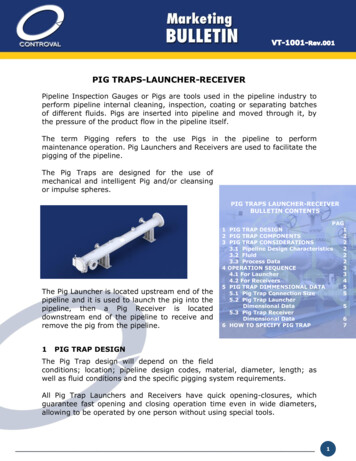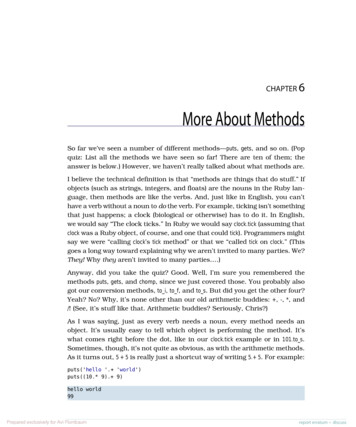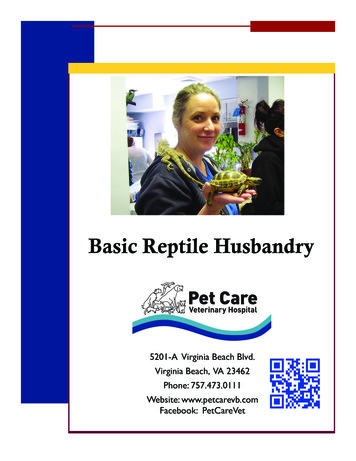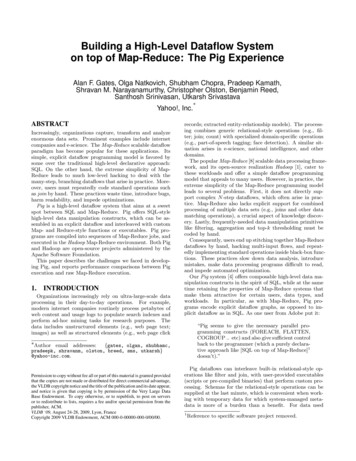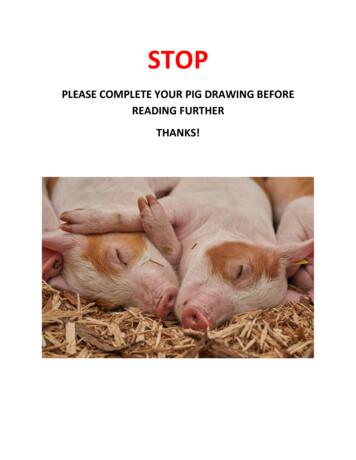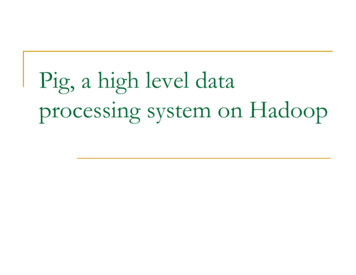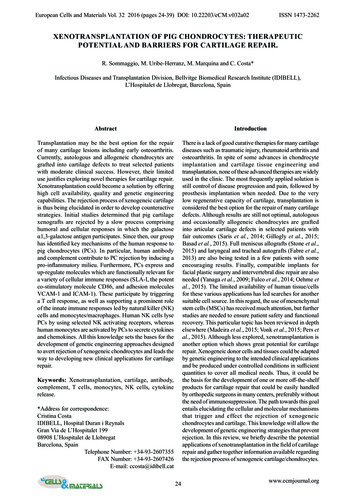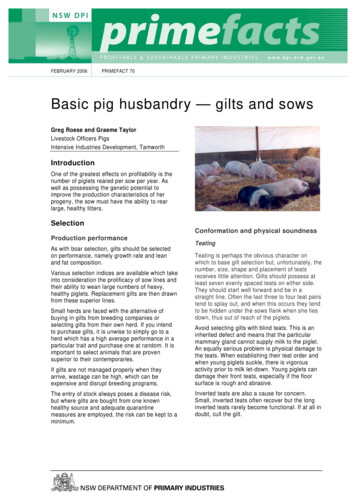
Transcription
FEBRUARY 2006PRIMEFACT 70Basic pig husbandry — gilts and sowsGreg Roese and Graeme TaylorLivestock Officers PigsIntensive Industries Development, TamworthIntroductionOne of the greatest effects on profitability is thenumber of piglets reared per sow per year. Aswell as possessing the genetic potential toimprove the production characteristics of herprogeny, the sow must have the ability to rearlarge, healthy litters.SelectionConformation and physical soundnessProduction performanceAs with boar selection, gilts should be selectedon performance, namely growth rate and leanand fat composition.Various selection indices are available which takeinto consideration the prolificacy of sow lines andtheir ability to wean large numbers of heavy,healthy piglets. Replacement gilts are then drawnfrom these superior lines.Small herds are faced with the alternative ofbuying in gilts from breeding companies orselecting gilts from their own herd. If you intendto purchase gilts, it is unwise to simply go to aherd which has a high average performance in aparticular trait and purchase one at random. It isimportant to select animals that are provensuperior to their contemporaries.If gilts are not managed properly when theyarrive, wastage can be high, which can beexpensive and disrupt breeding programs.The entry of stock always poses a disease risk,but where gilts are bought from one knownhealthy source and adequate quarantinemeasures are employed, the risk can be kept to aminimum.TeatingTeating is perhaps the obvious character onwhich to base gilt selection but, unfortunately, thenumber, size, shape and placement of teatsreceives little attention. Gilts should possess atleast seven evenly spaced teats on either side.They should start well forward and be in astraight line. Often the last three to four teat pairstend to splay out, and when this occurs they tendto be hidden under the sows flank when she liesdown, thus out of reach of the piglets.Avoid selecting gilts with blind teats. This is aninherited defect and means that the particularmammary gland cannot supply milk to the piglet.An equally serious problem is physical damage tothe teats. When establishing their teat order andwhen young piglets suckle, there is vigorousactivity prior to milk let-down. Young piglets candamage their front teats, especially if the floorsurface is rough and abrasive.Inverted teats are also a cause for concern.Small, inverted teats often recover but the longinverted teats rarely become functional. If at all indoubt, cull the gilt.
Short, thick teats are less desirable than longerthinner teats. Piglets have difficulty suckling shortteats and as the sow matures the teats increasein size and the problem is magnified.Gilts should be physically examined for thesedisorders. This means actually restraining herwhile an examination can take place.VulvaWhile the exact incidence of defects inreproductive organs is unknown, a wide variety ofabnormalities do occur.With visual selection the only reliable feature thatcan be accounted for is the shape, size andplacement of the vulva. It should be large,without sign of infantilism, and free of the ‘fishhook’ appearance found in hermaphrodites.Legs, feet and general conformationGilts must possess sound legs and feet withoutany sign of weakness. Pasterns should be strong,sloping to toes of even size. Gilts should be widethrough the hindquarters with depth andsquareness in the body cavity; ribs should be wellsprung.If the physical soundness of the gilt is in doubtshe should not be kept as a breeder. Breakdownlater in her breeding life can cause piglet losses,hardship and loss of productivity.TemperamentGilts should be quiet but alert and active. If thereis any tendency to be flighty or overly aggressive,they should be disregarded as future breeders.Feeding programGilts today are leaner, mature earlier and starttheir breeding lives with less body reserves. Theaim should be to have gilts ready to mate,weighing 120–130 kg liveweight at around28 weeks of age, with a backfat reading of atleast 18–20 mm. They should be in goodcondition but not overfat.After selection at 80–90 kg liveweight, the giltmay require a special feeding program to build upher fat cover to the desired level. If this is notachieved, her fat cover becomes depleted oversubsequent pregnancies, resulting in the ‘thinsow syndrome’ and her subsequent breakdown.Low specification dry sow diets are usuallyunsuitable, as a gilt diet should be at least 13.2megajoules (MJ) of digestible energy (DE) perkilogram and 0.5 grams of available lysine perMJ DE. Try to achieve a daily intake of around35 MJ DE.FlushingIt is important that the gilt has at least two trueheat periods before mating, to gain the increasein ovulation rate. For gilts, the ovulation rate canbe further increased by a high energy intake for10–14 days prior to service. This should bereduced for the first 3 days after mating.Increased feeding levels may then be made toensure adequate energy intakes, but prevent highenergy intakes between days 70 and 105 ofgestation.Signs of approaching oestrusWhile management plays an important part in thedevelopment of certain behaviours, manyproblems at farrowing time could be averted bycareful selection of gilt replacements.The length of the oestrus cycle is normally21 days and occurs regularly until the sow or giltbecomes pregnant. Gilts tend to have a shortercycle of 18–20 days.Care of giltsGiltsSelected gilts should be housed in groups in thebreeder shed to allow time for them to build upimmunities to organisms present in the breedingherd before gilts are mated. It is particularlyimportant to quarantine and acclimatisepurchased gilts on-farm for 6–7 weeks.When oestrus is approaching, there is increasedactivity, and also swelling and reddening of thevulva. A small amount of mucous appears, butthe gilt may not stand for the boar at this stage.Twelve to twenty-four hours later, the vulva willhave diminished in size, the mucous becomes theconsistency of light oil, and the gilt will respondto the back pressure test.Vaccination for diseases like E. coli, erysipelas,leptospirosis, mycoplasma and parvovirus shouldbe undertaken before the gilt is mated. Consultyour veterinary practitioner about a suitable herdhealth and quarantine program.Selected gilts should be exposed to a matureboar for 20 minutes daily (under supervision) tostimulate them to cycle earlier. An alternative isto use vasectomised boars, or to move weanedsows into the gilt pool as their urine containsoestrogen which acts as a stimulus.Basic pig husbandry - gilts and sows Primefact 70Only 50% of gilts will show the standing reflex orback pressure response in the absence of theboar. For this reason a gilt should be checked bya mature boar to determine whether she is onheat.The actual duration of the heat cycle is shorter ingilts and therefore her period of receptiveness isshorter. Staff should be alerted to this fact.2
SowsOestrus can be pinpointed more easily than inthe gilt. Normally a sow is in oestrus 3–10 daysafter the litter has been weaned.The sow becomes restless and frequently sniffsthe genitals of her pen mates. She will attempt tomount other sows or be mounted.There may be some swelling of the vulva,although only 75% of sows may exhibit this.There is, however, a clear vaginal discharge atthis time. As in the gilt, the sow may not stand tothe boar or the back pressure test at this stage.This usually occurs 12–24 hours later and themucous changes from being thin and watery tobecoming the consistency of light oil.Sows will normally accept the boar for some50 hours during the heat period. It is of interestthat the individual duration of heat in sows ishighly repeatable.It is important when conducting oestrus checksthat gilts or sows are taken close to a matureboar so that the important stimuli of smell andsound are most intense.Mate gilts when standing heat is first detected,and again 24 hours later. If detection is carriedout twice daily, you can delay the first mating12 hours, with the second mating occurring24 hours later.With sows, if detection is carried out once daily,mate at first detection and again 24 hours later,or wait 12 hours and remate 24 hours later. Ifdetection is done twice daily you can delay thefirst mating 12–24 hours, with the second mating24 hours later. If herd litter size is low, a thirdmating 12 hours after the second should beconsidered.Where possible, matings should be made beforefeeding and in the cool of the day in summermonths.Assistance at first matingIt is advisable to supervise and assist ifnecessary. Boars of similar weight and ageshould be used, but if this is not possible, aservice crate should be used. Rough handling bya vigorous boar may make a gilt nervous aboutlater matings, but it is important not to interfereunless necessary.Mating periodAfter weaning a litter, the sow normally returns tooestrus 3–10 days later and, if not successfullymated, will cycle every 21 days, although it mayvary to between 18 and 24 days. Placing the giltor sow in close proximity (i.e. within sight, soundand smell of the boar) will induce and aid in thedetection of oestrus. This is particularly importantduring cold weather as the transmission of thepheromones or boar odour is affected. It is also avery good argument for providing adequatewarmth in the boar pen and mating areas.Best results appear to occur when sows or giltsare separated from the boar by a 1 m widecorridor. When penned next to a boar they willapparently become conditioned by continuousand intense stimulation.It is normal to ‘batch farrow’ sows so that groupsof sows will be weaned and come on heattogether. Grouping sows or gilts opposite to theboar pens will also aid in the detection of thoseon heat.Timing of matingOvulation occurs between 38 and 42 hours afterthe onset of oestrous, and takes about 4 hours.As the sperm cells can survive longer than theova or eggs, the optimum time for service is priorto ovulation.Unfortunately it is not possible to predict this withany accuracy, so to overcome the problem thesow is mated at least twice during the standingheat period. The first service should take placesoon after the sow or gilt will stand.Basic pig husbandry - gilts and sows Primefact 70SupervisionWith supervised or hand matings, it is importantto take the sow or gilt to the boar’s pen or matingpen. She normally assumes the major role insearching out the male and this initial contact isimportant in replacing the social contactbehaviour with the sexual behaviour sequence.However, don’t leave them togetherunsupervised. If the sow is not on standing heatthe boar may become particularly aggressive andfrustrated, and injure himself or the sow.Check that vaginal entry takes place and the boardoes not serve into the rectum.Care after matingAfter mating, the sow or gilt should be returned toa pen or stall on her own, and then remated 12–18 hours later and the service date recorded. Ifthe sow or gilt has to be returned to a group ofsows, she should be washed or held until she hasgone off heat, and then returned.A check on the sow should be made 18–23 daysafter mating to see if there are any signs of herreturning to oestrus.Gestation periodThe first month after mating is critical, and anyform of stress must be avoided.Implantation of embryos occurs between day 11and day 18. Incorrect nutrition or stress can havean adverse effect on embryo survival. Conceptionrates can also be affected when mated sows are3
returned to a group of sows. Placing sows inindividual pens or stalls has many advantages.Feeding regimensWhile a pregnant sow uses feed more efficientlythan a dry sow, the actual feeding programemployed not only affects her performance in thatparticular pregnancy, but, more importantly, itaffects her future performance as a breeder.Feeding rates are determined by body weight,sow condition, stage of pregnancy, housing andtemperature.Table 1. Guide to feeding levels for gilts and sows(13.2 MJ DE/kg)Weeks1–45–1314–16Gilts1.8–2.3 kg1.8–2.3 kg2.0–4.5 kgSows2.0–2.5 kg2.0 kg2.2–2.5 kgGiltsEven though the gilt is still growing, a highfeeding level in the first month of pregnancy canincrease embryo mortality. As a guide, 1.8–2.3kg/day is ample for most gilts to obtain thedesired backfat reading of 25 mm by farrowingtime, and a 15 kg body weight increase afterweaning.Litter growth can be supported by increasing thefeed level by about 1–1.5 kg over the last2 weeks of gestation. At no stage should the giltbe overfed. Besides being wasteful, it results indifficulties at farrowing time and tremendousweight loss during lactation with subsequentbreeding and management difficulties.NB. Feeding heavily late in the pregnancydepresses appetite during lactation.Second and third littersDuring lactation, the sow should receive anenergy-dense diet. Where a lactating sow rationis used, it should provide a minimum 100 MJ DE,700 g crude protein and 50 g lysine per day. If aspecial lactating-sow ration is not available, thentry feeding a grower ration.It is advisable to continue feeding at generousrates after weaning and up to 2–3 days aftermating. Thereafter, feed 2.0–2.5 kg of a 12.5–13.0 MJ DE diet with 0.4 g availablelysine/MJ DE. Where considerable weight losshas occurred, higher than average feed levels forthe first month after mating may be necessary.The aim should be to have sows gain 10–15 kgliveweight after each cycle, with a backfatreading of at least 15 mm at weaning time.Basic pig husbandry - gilts and sows Primefact 70Fourth and subsequent littersBy this time, the sow has reached her maturebody size and thereafter a large increase in bodyweight is undesirable. The sow becomes heavyand clumsy, and more feed is required for hermaintenance. Bodyweight gain should stabilise,or at most a 5 kg liveweight gain is allowedbetween cycles and she is fed according to herbody condition.While the above practices are ideal, not all smallproducers have access to weigh crates for sowsor backfat testers. A system of condition scoringcan be used with success, as can ‘liveweightbands’ to determine weight gains in the vital firstfew pregnancies.Nutrient requirements are influenced a great dealby environmental conditions, therefore feedingprograms should be determined for individualpiggeries.General care and diseasepreventionToday, more and more sows are raised undertotal confinement, which makes it easier tocontrol feed intake (and thus weight gain) andreduce injury to the sows. Regular inspectionsshould be made to detect any signs of lameness,sore feet or injury and prompt treatment givenwhere necessary.Where vaccination for disease control ispractised, sows are ideally vaccinated 3–4 weeksbefore farrowing. Similarly, control of parasites istimely at this stage. Consult your veterinarian andread the Australian Pork Limited publicationPrinciples of vaccination.Farrowing periodProblems with sows at farrowing time are mainlydue to lack of care and attention of the sow andher farrowing quarters.Where possible each farrowing room shouldoperate on an all-in-all-out basis, which ispossible when using a batch farrowing system.Farrowing pensWhen a pen/room has been vacated, it should bethoroughly cleaned and disinfected. A highpressure hose or steam cleaner should be usedto remove any dirt or dung that has collected, andthen a disinfectant applied. Then pens should bedry before sows are placed in them.Any maintenance work that is required should becarried out before the pen is again occupied.Check that farrowing rails are secure, feedtroughs and watering facilities are not worn ordamaged, and the floor surface is in goodcondition. Where heat lamps or radiators areused, their position and operation should bechecked.4
Where piggeries operate on a batch farrowingsystem and/or are large enough to have separatefarrowing rooms, all the crates in the room andthe room itself can be disinfected before beingoccupied by the next batch of sows.Pre-farrowing treatmentConstipation can cause farrowing and lactationdifficulties on some farms, and a sow or gilt rationcan be reduced and diluted, with a bulky laxativematerial such as bran, 5–7 days before farrowing.Problems commonly occur when sows or gilts areallowed unlimited exercise prior to confinementand farrowing.Check the sow’s udder for ‘lumpiness’, which willindicate the presence of mastitis.Booking in sowsEverything should be in readiness long before thenext farrowing. Sows should be moved into theshed at least 3–4 days before farrowing, whilegilts should be allowed 5–7 days to becomeaccustomed to their new surroundings.Before being allowed to enter the maternitysection, sows and gilts should be thoroughlyscrubbed with warm and soapy water to removeany dirt and dung. Pay particular attention to theudder, feet and vulva. If external parasites arepresent, use a recommended insecticideaccording to the directions on the label. Apply amild disinfectant on the teats and vulva, and thenthe sow or gilt can be moved to the farrowingpen.If sows farrow-down in pens or yards, a smallamount of clean bedding, for example straw, canbe placed in them. Large quantities of beddingcan be dangerous for the new suckers,increasing the risk of being overlain. Care alsohas to be exercised if using bedding in slattedpens to avoid pit blockage.Make sure the sow cannot be accidentallyknocked out of her shed/pen, particularly duringwinter and before she has farrowed.Under no circumstances should a sow’s feedintake be increased at this late stage; in fact, aslight reduction is recommended. If constipationis still evident, an enema may have to beadministered.As farrowing time approaches, switch on heatlamps, check that they are working, and leavethem on to allow the creep areas to warm up.Move a heater to near the rear and one to theside of the sow.Signs of approaching farrowingThe actual signs of approaching parturition varywidely between individuals and the signs must beviewed collectively to ascertain when farrowingmay take place.Basic pig husbandry - gilts and sows Primefact 70As with other animals, when the vulva swells, theflank drops and there is an increase in the pulseand respiration rates prior to farrowing. However,about 48 hours prior to farrowing, a seroussecretion may be expressed from the teats,followed by some milk 24 hours before farrowing,with larger quantities 6–12 hours before.If allowed to farrow outside, the sow will make anest 1–3 days prior to farrowing. This bed-makingactivity can be continued with confined sows andusually occurs within 24 hours of farrowing andmore commonly 5–6 hours prior to farrowing.Prior to farrowing, the sow will become restlessand will lie down and get up constantly, and mayurinate frequently. As the intensity of contractionsincreases, she will lie down and utter low gruntswith an occasional whining sound. There may beat this time a slight discharge from the vulva.ParturitionThere is no standard form of presentation in pigs— they may be born with either head or tail first.Normally, the foetal sacs are ruptured at birthand thrown off by the piglets, but occasionallythey may cover the snout and cause suffocation.The umbilical cord is not always broken at birthand the piglet may wander around still attacheduntil the cord is broken.Sow behaviourThere is increased activity. The sow, andparticularly gilts, may stand as each of the firstfew piglets is born. She may twitch her tail priorto the birth of a piglet or the expulsion of fluid ormeconium.She may also try to roll as far as she can on toher back to improve access to her teats. Thesemovements and her attempts to get up and down,place the young piglets at great risk.The first farrowing is critical in the formation ofthe gilt’s subsequent farrowing and sucklingbehaviour, and it is wise to supervise thesefarrowings. Nervous sows may cause concern,and best results can be obtained by using a‘farrowing box’. Remove the piglets as they areborn, clean them, place them in a clean box witha small amount of litter, and suspend a heat lampabout 60 cm from the floor.If the sow or gilt continues to be restless andappears to be obviously agitated, she may haveto be injected with a suitable tranquilliser.Savaging can occur, especially with gilts, and atranquilliser is usually all that is required to settlethem down.Once the last piglet has been born and theafterbirth has been expelled, the sow will usuallylie quietly and allow her piglets to suckle.5
DurationFarrowing can take an average of 3–5 hours. Theactual time interval between the first and lastpiglet is around 2½ hours. However, it isconsiderably shorter with gilts, usually takingabout 1½ hours. Likewise, the average intervalbetween births is only about 12–15 minutes ingilts but extends to over 20 minutes with sows.If the interval is more than 25 minutes, thesecond piglet is more likely to be stillborn, andintervention should be made after delays of 25–30 minutes. If the actual farrowing time extendsbeyond 3 hours, stillbirths will increase.Action at farrowing timeWatch for splay-legged pigs. Taping their backlegs in a ‘figure 8’ pattern with electrical tape mayhelp support them.Postnatal or after-farrowing careCheck to see that the afterbirth has been passed,and in the case of a difficult farrowing a course ofantibiotics may be necessary. Consult yourveterinarian, as further treatment, such asvaginal irrigation, may be needed.Rectal temperatures should be taken for 24–48hours for any sign of trouble. While a vaginaldischarge is normal, excessive or purusdischarge should be treated promptly.While sows will usually farrow without assistance,supervision is desirable if trouble is to beavoided.Piglets are born with eight sharp needle or milkteeth which may lacerate the sow’s teats (andeach other) while competing for available teats,and cause infection.As the piglets are born, check to see that theirmouths are free of mucous and place them roundto the side of the sow to suckle. If your presenceis obviously upsetting the sow, withdraw and onlyintervene if a piglet is born in its foetal sac, if thepiglet is being rolled on, or if the sow is indifficulty.On some farms it is found necessary to clip theneedle teeth immediately after birth. If a historyof ‘naval ill’ or ‘joint ill’ is prevalent on thepiggery, the umbilical cords should be dipped intincture of iodine. Other operations that can becarried out are tail docking, administration of ironand medication.Record, on their card or in chalk on the pen, whattime the sows started farrowing. Check progressevery 15–30 minutes. If the period between thebirth of piglets is considered too long (over 30minutes) and the sow continues to strain, aninternal examination is desirable. At times thiscan be extremely difficult, and inexperiencedstockpersons should seek veterinary assistance,especially if a piglet is caught in the birth canal.Any sign of trouble in the sow should be treatedpromptly to minimise stress and loss of milkproduction.When sows have been checked they may requireinjections to stimulate contractions of the uterinemuscles.Lactation periodFor the first few days after farrowing, the sowshould be watched for any signs of constipation.The recommendation is to slowly increase thedaily ration of the sow, allowing her to build upher yield gradually and so keep pace with theincreasing requirements of the suckers.Some piglets, especially those removedmanually, are often comatosed due to lack ofoxygen. Prompt action will usually revive them: Clear the nose and mouth of mucous. Hold piglet by the hind legs and swingaround at arms length;orHold the piglet's mouth closed and blowgently into its nostrils. Check that the umbilical cord is not bleeding;tie or apply a cord clamp if required. Rub the piglet vigorously to dry it, and placeit in or under a source of heat. Allow piglets to suckle as soon as possible oradminister colostrum or glucose.It is important that piglets receive colostrum,which allows the transfer of passive immunity tothe piglets. Colostrum also contains a high levelof nutrients.Basic pig husbandry - gilts and sows Primefact 70On the day following farrowing, it is best to feedonly a light bran mash to get her bowels working,and a small amount of feed to keep her content.Heavy feeding of the sow at this stage can causescouring in the piglets and result in engorged,inflamed udders with the increased risk ofmastitis or agalactia.6
The sow can be fed lightly (say 1–1.5 kg) on thesecond day, and this can be increased by 0.5–1.0 kg per day until, at the end of the first week,she is receiving 2 kg for herself plus 400 g perpig suckled. However, this is only meant as aguide, as the amount fed will depend onenvironmental conditions, management practicesused, size of the sow, and weaning age etc. Thetarget should be 7 kg/day or ad lib feeding by 7–10 days after farrowingSows will convert feed at between 6:1 and 8:1,so the price of feed must be extremely low andbackfatter prices extremely high before youwould attempt to fatten sows.DietsResearch indicates that the second to seventh(inclusive) litters are the most economicallyproductive in a sow’s life. This would mean thatthey would be around 3–4 years of age at theirproductive peak.As already mentioned, the lactating sow shouldreceive a minimum 65–75 MJ DE, 700 g crudeprotein and 30 g lysine. The actual amount fedwill depend on environmental conditions andfactors like size of sow and litter size.The aim is to meet the requirements of lactationby high feeding levels and to minimise sow bodyweight losses and resultant breeding difficulties.It is advisable to feed a lactating sow a ration ofhigher nutrient density (e.g. 13.8–14.1 MJ DE,0.5 g/MJ available lysine) than is fed duringgestation. This is particularly important with giltsor small sows that have large litters — with lowdensity diets, they have extreme difficulty inconsuming sufficient feed to provide milk for thelitter and nutrient for their own maintenance.They use their own body fat to make up anydeficiency, with resultant severe bodyweightlosses.Every effort should be made to coax sows toconsume sufficient feed, to the extent of addingfeeds or flavourings to improve the feed’spalatability, or providing it as a wet mash.Feeding two to three times per day instead ofonce per day can also help.Peak milk yield is reached about the end of thethird week. The piglet’s growth demands outstripthe sow’s milk capacity at this stage, so tomaintain their growth, it is necessary to give themtheir own high quality feed. This creep feed canin fact be introduced as early as 4–5 days.As the due weaning date approaches, maintainthe sow’s feeding rate up until after she is mated.This is particularly important for the first three tofour litters, to help reduce sow weight loss, andduring the ‘weaning to remating’ periods. Thesehigh feeding levels may also help increase theovulation rate.On the date of weaning, the sow is removed fromher litter and penned out of sight, sound andsmell. This pen is usually in close proximity to theboar, to help stimulate her to come on heat.If the decision is made to sell a brood sow, waituntil the udder has dried up. Do not try to fattenher unless you have access to very cheap feed.Basic pig husbandry - gilts and sows Primefact 70When sows are no longer part of the breedingunit in the herd, it is false economy to have themholding down accommodation space meant forproductive sows.ReplacementReplacement gilts should be brought in on aregular basis. If this is not done, there can befluctuations in the number of farrowings, causingmanagement problems with overcrowding orunderstocking.Having large groups of gilts coming into farrowtogether can cause unnecessary difficulties. Attimes, this may be necessary but it does requirean increase in supervision at farrowing.The actual number of gilts required can bedetermined reasonably accurately some monthsahead by making use of farrowing and ‘expected’mating charts. Where batch farrowing ispractised, replacement numbers can be moreeasily calculated.However, a decision on the percentage of sowsto be culled per year has to be made so that aregular culling and replacement program can beimplemented.On occasions, a sow might become sick, lame oreven die. If this occurs in the farrowing orlactation period, a replacement would have to befound at short notice.Piggeries which are ‘self-replacing’ can operate agilt pool from which replacements can be takenand mated to maintain the farrowing program.Further informationA wide range of information sources exists forthose interested in the pig industry.Australian Pork Limited (APL) is the nationalrepresentative non-profit organisation forAustralian pig producers. It combines marketing,export development, research, innovation andstrategic policy development to help develop aviable and sustainable industry. Resources andcontacts are listed on their website:http://www.australianpork.com.au/or they can be contacted on 1800 789 099.Specific APL publications with more detailedinformation are as follows:7
Farrowing kit Mating and reproduction (2004 edition) Segregated early weaning manual The good health manual kit Principles of vaccinationThe Queensland Department of PrimaryIndustries & Fisheries has an extensive range offact sheets and resources available on theirwebsite: http://www.dpi.qld.gov.au/pigs/A number of pig-specific magazines andnewspapers exist, including: Australian Pork Newspaper, (07) 3286 1833 Pig Industry News, (08) 8372 5222 Pork Journal, (02) 9798 3078 The Pork Producer, (07) 4690 9253Published by NSW Department of Primary Industries State of New South Wales 2006ISSN 1832-6668Job number 6155Updates of this Primefact are available atwww.dpi.nsw.gov.au/primefactsALWAYS READ THE LABEL: Users of agricultural (orveterinary) chemical products must always read the labeland any Permit before using the product, and strictlycomply with the dir
Sows Oestrus can be pinpointed more easily than in the gilt. Normally a sow is in oestrus 3-10 days after the litter has been weaned. The sow becomes restless and frequently sniffs
